Unit 9 翻译中的文化意识
- 格式:pdf
- 大小:321.38 KB
- 文档页数:9


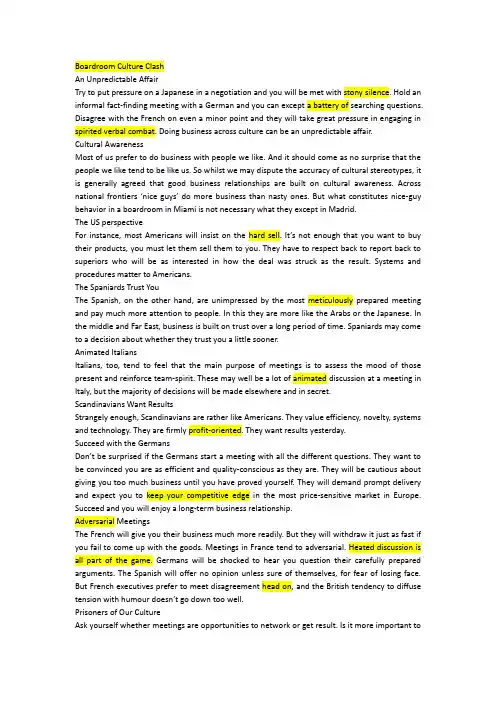
Boardroom Culture ClashAn Unpredictable AffairTry to put pressure on a Japanese in a negotiation and you will be met with stony silence. Hold an informal fact-finding meeting with a German and you can except a battery of searching questions. Disagree with the French on even a minor point and they will take great pressure in engaging in spirited verbal combat. Doing business across culture can be an unpredictable affair.Cultural AwarenessMost of us prefer to do business with people we like. And it should come as no surprise that the people we like tend to be like us. So whilst we may dispute the accuracy of cultural stereotypes, it is generally agreed that good business relationships are built on cultural awareness. Across national frontiers ‘nice guys’ do more business than nasty ones. But what constitutes nice-guy behavior in a boardroom in Miami is not necessary what they except in Madrid.The US perspectiveFor instance, most Americans will insist on the hard sell. It’s not enough that you want to buy their products, you must let them sell them to you. They have to respect back to report back to superiors who will be as interested in how the deal was struck as the result. Systems and procedures matter to Americans.The Spaniards Trust YouThe Spanish, on the other hand, are unimpressed by the most meticulously prepared meeting and pay much more attention to people. In this they are more like the Arabs or the Japanese. In the middle and Far East, business is built on trust over a long period of time. Spaniards may come to a decision about whether they trust you a little sooner.Animated ItaliansItalians, too, tend to feel that the main purpose of meetings is to assess the mood of those present and reinforce team-spirit. These may well be a lot of animated discussion at a meeting in Italy, but the majority of decisions will be made elsewhere and in secret.Scandinavians Want ResultsStrangely enough, Scandinavians are rather like Americans. They value efficiency, novelty, systems and technology. They are firmly profit-oriented. They want results yesterday.Succeed with the GermansDon’t be surprised if the Germans start a meeting with all the different questions. They want to be convinced you are as efficient and quality-conscious as they are. They will be cautious about giving you too much business until you have proved yourself. They will demand prompt delivery and expect you to keep your competitive edge in the most price-sensitive market in Europe. Succeed and you will enjoy a long-term business relationship.Adversarial MeetingsThe French will give you their business much more readily. But they will withdraw it just as fast if you fail to come up with the goods. Meetings in France tend to adversarial. Heated discussion is all part of the game. Germans will be shocked to hear you question their carefully prepared arguments. The Spanish will offer no opinion unless sure of themselves, for fear of losing face. But French executives prefer to meet disagreement head on, and the British tendency to diffuse tension with humour doesn’t go down too well.Prisoners of Our CultureAsk yourself whether meetings are opportunities to network or get result. Is it more important tostick to the agenda or generate new ideas? Is the main aim of a meeting to transmit or pool information? It all depends on where in the world you hold your meeting and whether you belong to an individualistic business culture like the French, Germans and Americans or to a collective one like the British, Japanese and Greeks. Indeed, who knows to what extent culturally conditioned? For in business, as in life, “All human beings are captives of their culture.”岩石一般的沉寂;一声不吭一系列激烈的争论硬卖,强行推销小心翼翼地活跃的,活泼的以赢利为目的保持你的竞争力敌手的,对手的整个会议过程中都充满了激烈的讨论迎面的,正面的所有人都是他们的文化俘虏。
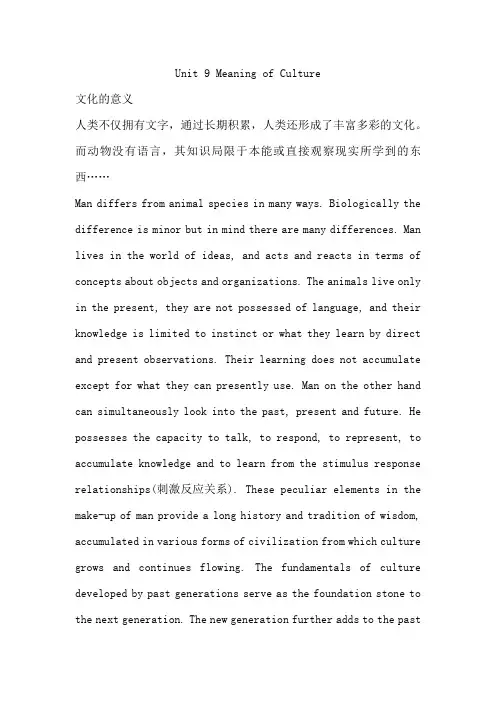
Unit 9 Meaning of Culture文化的意义人类不仅拥有文字,通过长期积累,人类还形成了丰富多彩的文化。
而动物没有语言,其知识局限于本能或直接观察现实所学到的东西……Man differs from animal species in many ways. Biologically the difference is minor but in mind there are many differences. Man lives in the world of ideas, and acts and reacts in terms of concepts about objects and organizations. The animals live only in the present, they are not possessed of language, and their knowledge is limited to instinct or what they learn by direct and present observations. Their learning does not accumulate except for what they can presently use. Man on the other hand can simultaneously look into the past, present and future. He possesses the capacity to talk, to respond, to represent, to accumulate knowledge and to learn from the stimulus response relationships(刺激反应关系). These peculiar elements in the make-up of man provide a long history and tradition of wisdom, accumulated in various forms of civilization from which culture grows and continues flowing. The fundamentals of culture developed by past generations serve as the foundation stone to the next generation. The new generation further adds to the pastaccumulation of civilization and culture and enables man to continually assimilate in the stream of culture. Thus man continues to live as a civilized and cultured member of society. Scientific inventions and discoveries greatly influence cultural variability(变化性,易变性). They affect tradition, customs, beliefs and faiths. They not only affect the present and future ideology(意识形态) of society but also practically bring about changes in artistic products and cultural environment. They quite often undermine the spiritual aspect of cultural life and provide material patterns. Inventions and discoveries bring about changes in the mode of production, art, morals, customs, laws, literature, etc. the changing mode of production affects the culture. Karl Marx held that the culture of capitalist countries differed from that of socialist countries because of the differences in the modes of production.What does culture do? The first function of culture is to make man a human being. It is culture that regulates his conduct and prepares him for group life. It teaches him the art of living as per the cultural traits of the group. He takes the food, wears the clothes, goes to school, speaks the language and does so many other little things of day-to-day life which are a partof the conventional norms, mores(风俗), laws, customs and morals of the group. The culture of a group plays a major part in the heightening human qualities of its individuals and save them from avoiding participation in the cultural stream.The culture of the group must give to its individual the capacity to lead a social life as an effective member of society. With the induction of the individual as an effective participant in the social life of the group, one can greatly gain by the utilization of energy of the individual in different constructive activities, which not only provides satisfaction on to the individual but also benefits the group.The second important role of culture is to keep social relationship intact so that the group as a whole can maintain and develop the value s and ideals of the group through the regulation of behaviors of its members and by satisfying their primary needs and objectives in respect of the necessities and luxuries of life. People learn to behave socially in a group because their behavior is subject to approval or disapproval. The culture of a group provides a number of controls on the irrational conducts for its members. It organizes many cultural aids like schooling, provision of work, outlet to talent, etc. these outlets go to provide rationality and responsibility tothe members and integrate them mentally, morally and sentimentally in the group. A culturally advanced group is also capable of providing a coordinated set-up to take the best out of each member and in return give the necessary comfort for personal development, recreation and emotional living. It must also provide other facilities for broadening the vision of the individual members so as to provide necessary motivations for creation in different fields of social activity including production of pieces of art, handicrafts and scientific implements and equipments which the group may need for the satisfaction of its different cultural and material requirements.The next important function of culture is to instantly provide new interpretation to different situations arising from the traditional cultural elements transmitted to the group. Provision of interpretation to traditional culture helps the reorientation (重新定位)of present and future cultural trends, putting them on the right track. For instance, in the modern era it is the duty of the school and other institution of a group to tell its members that if a cat crosses his way he needs not consider it unfortunate and give up the new projects, which is needed in the modern norms of society.However, these interpretations based on tradition may differ from culture to culture. Among some cultures the owl may still be regarded as a symbol of bad luck while in others it may be symbol of wisdom.The principle of cultural diffusion has been advocated by three German scholars. Cultural diffusion is the process by which the cultural trades of one group of society are spread directly or indirectly to other societies. It is historically established that some societies have served as centers of cultural unification. After the birth of Christ was born a cultural center, from where many cultural trades in the field of art and political organization got diffused to the northwestern Europe and to the east up to India. Subsequently Rome(罗马)became a great cultural center from where Roman law spread in most countries of Europe. In ancient time India was the cultural center from where many cultural trade spread eastward up to Indonesia(印度尼西亚) and passed through the fourteenth century. European culture became the dominant element in Asia and Africa and even America. At present the United States and Russia are exporting their respective cultures to different countries.Several factors influence the diffusion of culture. Theforemost is the capacity of the cultural center to inspire other countries to import the culture. The most important vehicle of cultural diffusion is mass communication, tourism, and exchange of educational and cultural delegations and teams, literature, films, etc. Obstruction to cultural diffusion may sometimes arise from the refusal of a group to borrow or import from the other group. Such a group tends to become an island of local culture untouched by the culturally developed countries. Sometimes a cultural island may exist within a larger cultural island. For example, in India the caste(印度的世袭等级)system that has separated Brahmins(印度的婆罗门阶级)from the other social groups for many generations on supposed biological superiority may reject a foreign cultural form, as they fear its impact on the prevail moral norms and social value s. It is for this reason that cultural centers of new value s find it more expeditious to invade foreign cultures through such means as the mass media. This process, although indirect and slow, has in due course a lasting impact as it appeals to the coming generations of the foreign countries which are still not fully socialized to the local cultures. For example, the young age groups in India were subjected to cultural influence of the Beatles(披头士乐队,甲壳虫乐队) forquite a long time.。
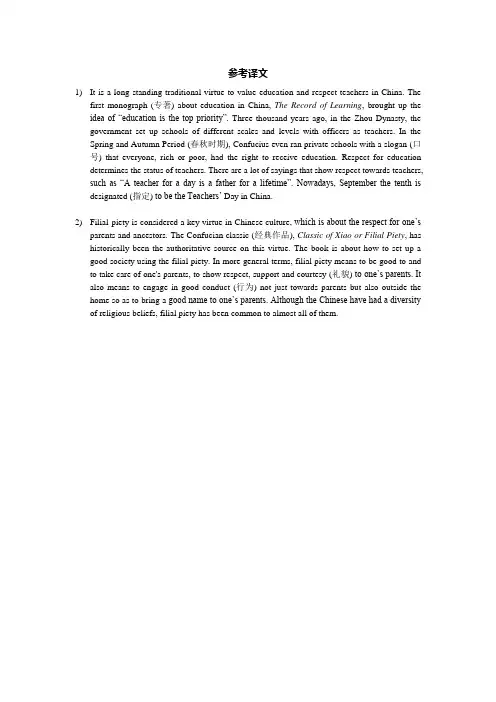
参考译文1)It is a long-standing traditional virtue to value education and respect teachers in China. Thefirst monograph (专著) about education in China, The Record of Learning, brought up the idea of “education is the top priority”. Three thousand years ago, in the Zhou Dynasty, the government set up schools of different scales and levels with officers as teachers. In the Spring and Autumn Period (春秋时期), Confucius even ran private schools with a slogan (口号) that everyone, rich or poor, had the right to receive education. Respect for education determines the status of teachers. There are a lot of sayings that show respect towards teachers, such as “A teacher for a day is a father for a lifetime”. Nowadays, September the tenth is designated (指定) to be the Teachers’ Day in China.2)Filial piety is considered a key virtue in Chinese culture, which is about the respect for one’sparents and ancestors. The Confucian classic (经典作品), Classic of Xiao or Filial Piety, has historically been the authoritative source on this virtue. The book is about how to set up a good society using the filial piety. In more general terms, filial piety means to be good to and to take care of one's parents, to show respect, support and courtesy (礼貌) to one’s parents. It also means to engage in good conduct (行为) not just towards parents but also outside the home so as to bring a good n ame to one’s parents. Although the Chinese have had a diversity of religious beliefs, filial piety has been common to almost all of them.。
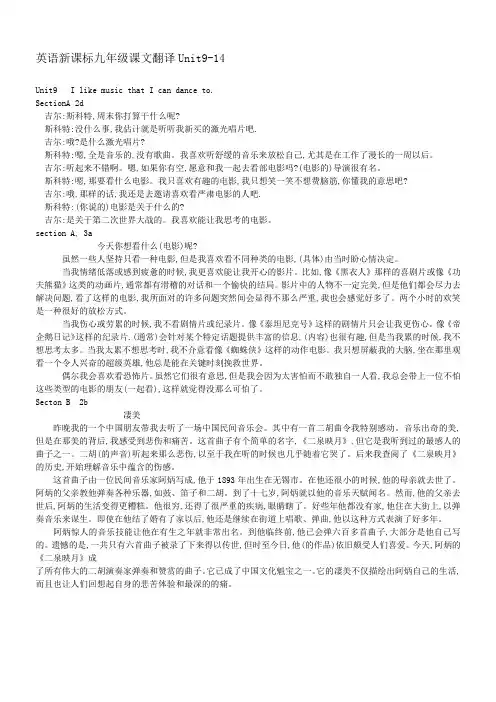
英语新课标九年级课文翻译Unit9-14Unit9 I like music that I can dance to.SectionA 2d吉尔:斯科特,周末你打算干什么呢?斯科特:没什么事,我估计就是听听我新买的激光唱片吧.吉尔:哦?是什么激光唱片?斯科特:嗯,全是音乐的,没有歌曲。
我喜欢听舒缓的音乐来放松自己,尤其是在工作了漫长的一周以后。
吉尔:听起来不错啊。
嗯,如果你有空,愿意和我一起去看部电影吗?(电影的)导演很有名。
斯科特:嗯,那要看什么电影。
我只喜欢有趣的电影,我只想笑一笑不想费脑筋,你懂我的意思吧?吉尔:哦,那样的话,我还是去邀请喜欢看严肃电影的人吧.斯科特:(你说的)电影是关于什么的?吉尔:是关于第二次世界大战的。
我喜欢能让我思考的电影。
section A, 3a今天你想看什么(电影)呢?虽然一些人坚持只看一种电影,但是我喜欢看不同种类的电影,(具体)由当时盼心情决定。
当我情绪低落或感到疲惫的时候,我更喜欢能让我开心的影片。
比如,像《黑衣人》那样的喜剧片或像《功夫熊猫》这类的动画片,通常都有滑稽的对话和一个愉快的结局。
影片中的人物不一定完美,但是他们都会尽力去解决问题,看了这样的电影,我所面对的许多问题突然间会显得不那么严重,我也会感觉好多了。
两个小时的欢笑是一种很好的放松方式。
当我伤心或劳累的时候,我不看剧情片或纪录片。
像《泰坦尼克号》这样的剧情片只会让我更伤心。
像《帝企鹅日记》这样的纪录片,(通常)会针对某个特定话题提供丰富的信息,(内容)也很有趣,但是当我累的时候,我不想思考太多。
当我太累不想思考时,我不介意看像《蜘蛛侠》这样的动作电影。
我只想屏蔽我的大脑,坐在那里观看一个令人兴奋的超级英雄,他总是能在关键时刻挽救世界。
偶尔我会喜欢看恐怖片。
虽然它们很有意思,但是我会因为太害怕而不敢独自一人看,我总会带上一位不怕这些类型的电影的朋友(一起看),这样就觉得没那么可怕了。
Secton B 2b凄美昨晚我的一个中国朋友带我去听了一场中国民间音乐会。

中国古代十大名曲有先秦的琴师伯牙的《高山流水》;汉魏时期嵇康的《广陵散琴曲》;明朝的《平沙落雁》;古曲《梅花三弄》楚汉战争时期的《十面埋伏》;古乐曲《夕阳萧鼓》后编成丝竹乐曲《春江花月夜》;历代传谱的《渔樵问答》汉末汉文姬的《胡笳十八拍》;汉代的《汉宫秋月》;春秋时期晋国师旷的《阳春白雪》。
补充概括:1、高山流水传说先秦的琴师伯牙一次在荒山野地弹琴,樵夫钟子期竟能领会这是描绘“巍巍乎志在高山”和“洋洋乎志在流水”。
伯牙惊曰:“善哉,子之心与吾同。
”子期死后,伯牙痛失知音,摔琴断弦,故有高山流水之曲。
《高山流水》一曲被录入金唱片上,于1977年8月22日发射到太空,向宇宙星球的高级生物传道中华民族的智慧和文明信息。
2、广陵散据《琴操》记载:战国聂政的父亲,为韩王铸剑,因延误日期,而惨遭杀害,聂政立志为父亲报仇,入山学琴十年,身成绝技,名扬韩国。
韩王召他进宫演奏,聂政终于实现了刺杀韩王的报仇夙愿,自己也毁容而死。
后人根据这个故事,谱成琴曲,慷慨激昂,气势宏伟,为古琴著名大曲之一。
据《琴议》记载:嵇康非常喜爱《广陵散》,经常弹奏它,以致招来许多人前来求教,但嵇康概不传授。
死前索琴弹奏此曲,并慨然长叹:“《广陵散》如今绝矣”。
南京西善桥南朝墓出土模制嵇康画像砖,描绘了嵇康席坐抚琴,气宇昂轩的形象。
3、平沙落雁明朝此曲称《落雁平沙》。
曲调悠扬流畅,通过时隐时现的雁鸣,描写雁群降落前在天空盘旋顾盼的情景。
对于曲情的理解,有“取清秋寥落之意,鸿雁飞鸣”来描写秋天景物的;有“取秋高气爽,风静沙平,云程万里,天际飞鸣,借鸿鹄之远志,写逸士之心胸”的;也有从鸿雁“回翔瞻顾之情,上下颉颃之态,翔而后集之象,惊而复起之神”。
“既落则沙平水远,意适心闲,朋侣无猜,雌雄有叙”,发出世事险恶,不如雁性的感慨的。
现在流传的多树是七段,主要的音调和音乐形象大致相同,旋律起而又伏,绵延不段,优美动听;基调静美,但静中有动。
4、梅花三弄曲中泛音曲调在不同徽位上重复了三次,故称“三弄”。
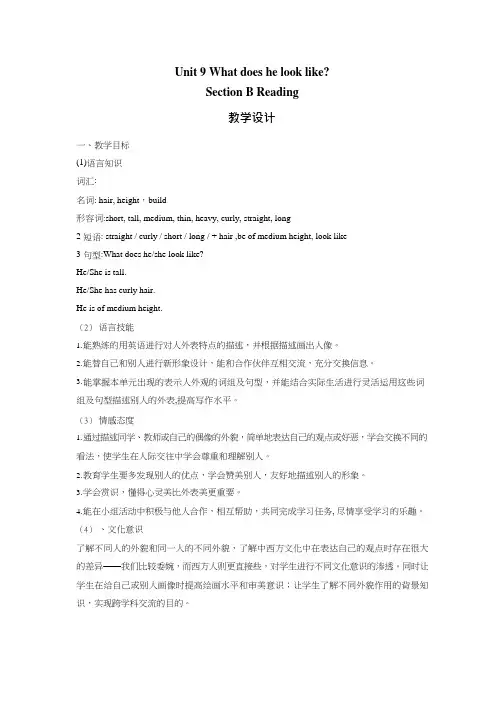
Unit 9 What does he look like?Section B Reading教学设计一、教学目标(1)语言知识词汇:名词: hair, height,build形容词:short, tall, medium, thin, heavy, curly, straight, long2 短语: straight / curly / short / long / + hair ,be of medium height, look like3 句型:What does he/she look like?He/She is tall.He/She has curly hair.He is of medium height.(2)语言技能1.能熟练的用英语进行对人外表特点的描述,并根据描述画出人像。
2.能替自己和别人进行新形象设计,能和合作伙伴互相交流,充分交换信息。
3.能掌握本单元出现的表示人外观的词组及句型,并能结合实际生活进行灵活运用这些词组及句型描述别人的外表,提高写作水平。
(3)情感态度1.通过描述同学、教师或自己的偶像的外貌,简单地表达自己的观点或好恶,学会交换不同的看法,使学生在人际交往中学会尊重和理解别人。
2.教育学生要多发现别人的优点,学会赞美别人,友好地描述别人的形象。
3.学会赏识,懂得心灵美比外表美更重要。
4.能在小组活动中积极与他人合作,相互帮助,共同完成学习任务, 尽情享受学习的乐趣。
(4)、文化意识了解不同人的外貌和同一人的不同外貌,了解中西方文化中在表达自己的观点时存在很大的差异——我们比较委婉,而西方人则更直接些,对学生进行不同文化意识的渗透。
同时让学生在给自己或别人画像时提高绘画水平和审美意识;让学生了解不同外貌作用的背景知识,实现跨学科交流的目的。
二、教学重难点教学重点:1. The vocabulary.2.--What does he/she look like? --He/She is tall.--What do you look like? --I’m thin.I have short straight hair.教学难点:Use the language to talk about sb’s appearance.三、教学过程Step1. Play a guessing gameI will show three pictures and the description. The students can guess what he is.(猜测游戏,调动学生的积极性,能熟练的用英语进行对人外表特点的描述)Step2. 师徒互查—师傅提问学友n. 艺术家v. 描述n. 犯罪活动adv. 不同地n. 罪犯adj.&pron. 另一的v. 放n. 结尾;尽头adj.&pron. 每个;各自adj. 真正的;真实的n. 方式;路线以相同的方式,反过来,学友挑战师傅。

某某省某某市第四中学八年级英语上册 Unit 9《When was he born》教学设计人教新目标版新颁布的《国家中长期教育改革和发展规划纲要》的战略主题是坚持以人为本、全面实施素质教育是教育改革发展的战略主题,其核心是解决好培养什么人、怎样培养人的重大问题,明确指出了要着力提高学生的学习能力、实践能力、创新能力。
本课设计以此为理念,基于课程标准,教材解读,基于学习起点,以学生为主体,学习是课堂的主线,学得是评价的主尺,开展教学,旨在培养学生的学习能力、实践能力、创新能力。
创意解说:本课本课教学内容来源于英语(Go For It)八年级上册Unit 9 When was he born?Section B3a-4。
本节课的教学目标定位于用以读促写的形式,融合词汇教学、训练学生阅读技能以达到写作指导并培养学生的综合运用英语的能力。
英语教学的最终目标是让学生通过运用英语进行交际和思考。
尤其是这节课中要让学生通过英语阅读和写作体会到如何了解和欣赏他人。
本节课就是基于这个目的进行以下几方面的创意设计:创意设计之一:在与学生的交流过程中引导学生思考通过摄取基本信息去了解一个人。
此设计帮助学生了解所学的英语确有交际运用功能,能帮助他们与初识者交流。
创意设计之二:将英语阅读理解教材处理为X本而不是单纯的阅读理解文章。
阅读教学要达到多种教学目的,本科采用以读促写的形式,实实在在让学生体会文章的立意、框架以及如何搭好这个框架的过程。
创意设计之三:将阅读所学进行分层递进训练,训练学生从规定内容的写作到其自由发挥。
在写作过程中给出及时、具体、恰当的写作指导,让学生有写作的思路和依据,在写作过程中遇到的困难和疑惑能及时得到解决,最后能在与同学的交流中得到肯定与欣赏,并学会如何欣赏和肯定他人。
教学设计:【教材分析】《新目标英语》教材的语言教育理念是:知识用于行动,强调“语言应用”,培养“创新、实践能力”,发展“学习策略”,培养学生使用英语获取信息、进行交流,并培养学生运用英语解决实际问题的能力。

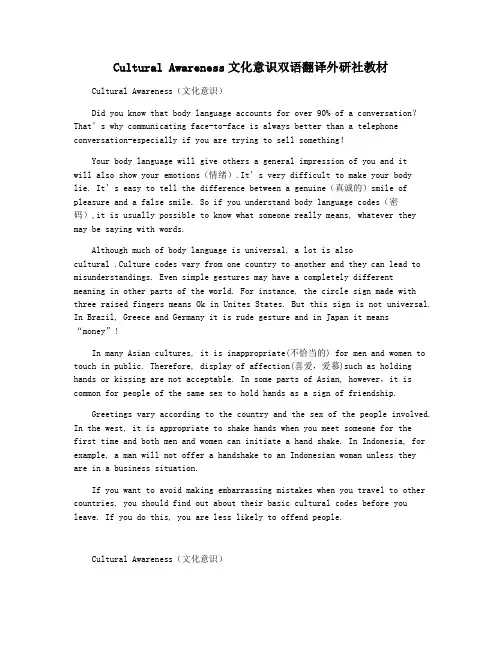
Cultural Awareness文化意识双语翻译外研社教材Cultural Awareness(文化意识)Did you know that body language accounts for over 90% of a conversation?That’s why communicating face-to-face is always better than a telephone conversation-especially if you are trying to sell something!Your body language will give others a general impression of you and itwill also show your emotions(情绪).It’s very difficult to make your bodylie. It’s easy to tell the difference between a genuine(真诚的)smile of pleasure and a false smile. So if you understand body language codes(密码),it is usually possible to know what someone really means, whatever they may be saying with words.Although much of body language is universal, a lot is alsocultural .Culture codes vary from one country to another and they can lead to misunderstandings. Even simple gestures may have a completely different meaning in other parts of the world. For instance, the circle sign made with three raised fingers means Ok in Unites States. But this sign is not universal. In Brazil, Greece and Germany it is rude gesture and in Japan it means “money”!In many Asian cultures, it is inappropriate(不恰当的) for men and women to touch in public. Therefore, display of affection(喜爱,爱慕)such as holding hands or kissing are not acceptable. In some parts of Asian, however,it is common for people of the same sex to hold hands as a sign of friendship.Greetings vary according to the country and the sex of the people involved. In the west, it is appropriate to shake hands when you meet someone for thefirst time and both men and women can initiate a hand shake. In Indonesia, for example, a man will not offer a handshake to an Indonesian woman unless theyare in a business situation.If you want to avoid making embarrassing mistakes when you travel to other countries, you should find out about their basic cultural codes before you leave. If you do this, you are less likely to offend people.Cultural Awareness(文化意识)你知道肢体语言占交谈的90%以上吗?那就是为什么面对面的交谈总是比电话交谈要好的原因――尤其是当你尽力出售东西时!肢体语言会给他人留下对你的总体印象,也会显示出你的情绪。
八年级英语上册-人教版-Unit 9 教案一. 教材分析人教版八年级英语上册Unit 9主要围绕着“节假日”这一主题展开,通过学习本单元,学生能够掌握关于节日的词汇和表达方式,了解不同国家的节日习俗,提高听说读写的能力。
本单元包括两个阅读文本,分别是关于春节和西方节日的介绍。
二. 学情分析八年级的学生已经具备了一定的英语基础,能够听懂并运用简单的日常英语进行交流。
但部分学生在阅读和写作方面还存在一定的困难,对一些文化背景知识了解不足。
因此,在教学过程中,需要关注学生的个体差异,调动他们的学习积极性,提高他们的综合语言运用能力。
三. 教学目标1.知识目标:学生能够掌握关于节日的词汇和表达方式,了解不同国家的节日习俗。
2.能力目标:学生能够听懂、说清、读懂并写出一个关于节日的短文。
3.情感目标:培养学生对不同文化的尊重和理解,提高他们的跨文化交际意识。
四. 教学重难点1.重点:掌握关于节日的词汇和表达方式,了解不同国家的节日习俗。
2.难点:能够运用所学知识,编写一个关于节日的短文。
五. 教学方法1.任务型教学法:通过完成各种任务,激发学生的学习兴趣,提高他们的实践能力。
2.情境教学法:创设真实的语境,让学生在实践中学习,提高他们的语言运用能力。
3.文化教学法:介绍节日背后的文化背景,培养学生对不同文化的尊重和理解。
六. 教学准备1.教师准备:备好相关节日的教学材料,如图片、视频、阅读文本等。
2.学生准备:预习相关节日的词汇和表达方式,了解自己国家的节日习俗。
七. 教学过程1.导入(5分钟)教师通过提问方式引导学生谈论自己喜欢的节日,从而引出本课主题。
2.呈现(10分钟)教师展示与节日相关的图片和视频,引导学生用英语描述图片内容。
3.操练(15分钟)教师学生进行角色扮演,模拟节日场景,让学生在实际语境中运用所学知识。
4.巩固(10分钟)教师给出一个关于节日的句子,要求学生用所学的词汇和表达方式进行改写。
任教八年级下英语第九单元的文化知识The cultural knowledge covered in the 9th unit of the 8th grade English curriculum is a fascinating exploration of the diverse customs and traditions found around the world. As an English teacher tasked with imparting this information to my students, I am excited to delve into the rich tapestry of global cultures and share their unique perspectives and practices.At the heart of this unit lies the fundamental understanding that culture is not a static entity but rather a dynamic and ever-evolving phenomenon. It is the manifestation of a people's collective experiences, beliefs, and values, shaping their worldview and influencing their interactions with others. By examining the cultural knowledge within this unit, we can gain a deeper appreciation for the intricate nuances that define different societies and the ways in which they navigate the complexities of the human experience.One of the key aspects of the cultural knowledge covered in this unit is the concept of cultural identity. Students will explore how individuals and communities construct and express their sense of selfin relation to their cultural heritage. This includes delving into the significance of language, traditions, and customs as markers of cultural identity, as well as the ways in which these elements can be preserved, celebrated, and shared with others.Through this exploration, students will develop a greater understanding of the diversity that exists within and across cultures. They will learn about the unique customs and rituals that are deeply rooted in the histories and belief systems of different societies, from the vibrant festivals and celebrations to the intricate social structures and hierarchies. By understanding the cultural knowledge of this unit, students will be equipped to navigate the increasingly globalized world with empathy, respect, and a genuine appreciation for the richness of human diversity.Moreover, the cultural knowledge in this unit extends beyond the mere acquisition of facts and figures. It encourages students to engage in critical thinking and analysis, examining the ways in which cultural practices and beliefs shape and are shaped by the broader social, political, and economic contexts in which they exist. This holistic approach to cultural understanding fosters a deeper level of engagement and a more nuanced appreciation for the complexities that underlie the human experience.As an educator, I am particularly excited about the opportunity toexplore the role of cultural exchange and interaction within this unit. Students will delve into the ways in which cultures have historically influenced and been influenced by one another, exploring the dynamics of cultural diffusion, adaptation, and hybridization. This knowledge not only broadens their understanding of the world but also equips them with the tools to navigate the increasingly interconnected global landscape.Furthermore, the cultural knowledge in this unit extends beyond the purely academic realm, as it holds the potential to cultivate important life skills and personal growth. By exploring the diverse customs and traditions of different cultures, students will develop a greater sense of empathy, cultural sensitivity, and openness to new perspectives. This, in turn, can foster more meaningful and respectful relationships with individuals from diverse backgrounds, both within their own communities and on a global scale.As an English teacher, I am committed to ensuring that my students not only acquire the linguistic skills necessary for effective communication but also develop a deep understanding and appreciation for the cultural knowledge that underpins the language they are learning. By guiding them through the fascinating exploration of the 9th unit's cultural content, I aim to instill in them a lifelong curiosity and respect for the rich tapestry of human diversity.In conclusion, the cultural knowledge covered in the 9th unit of the 8th grade English curriculum is a powerful tool for expanding students' worldviews, fostering cross-cultural understanding, and cultivating essential life skills. As an educator, I am honored to be entrusted with the responsibility of sharing this knowledge and empowering my students to become informed, empathetic, and globally-minded individuals. Through this unit, they will not only deepen their understanding of the English language but also gain a profound appreciation for the diversity that makes our world such a vibrant and interconnected place.。
翻译中的文化意识
在中文翻译中,文化意识起着非常重要的作用。
由于中文和其他语言
之间存在着文化差异,翻译人员需要了解并考虑到目标语言的文化背景、
价值观和语言表达习惯。
下面是一些常见的与中文翻译中的文化意识相关
的方面:
1.礼貌和尊重:在中文中,礼貌用语和恭敬称谓非常重要。
翻译人员
需要在译文中恰当地体现出这些文化特点,以表达对他人的尊重。
例如,
适当使用敬语、称呼对方的职位或尊称等。
2.文化象征和隐喻:中文中经常使用一些象征性的词语和隐喻,这些
词语和表达方式在不同的文化中可能具有不同的意义。
翻译人员需要理解
这些文化象征和隐喻,并根据目标语言的文化背景进行适当的转换或解释。
3.文化习俗和节日:翻译人员需要了解各种中文文化习俗和节日,以
便在翻译过程中准确地传达相关信息。
例如,春节、中秋节和清明节等传
统节日对于中文社会具有重要意义,翻译人员需要对这些节日的文化内涵
进行准确的传达。
4.社会礼仪和行为准则:中文社会有一套独特的社会礼仪和行为准则,翻译人员需要熟悉这些规范,并在翻译中体现出来。
例如,家庭观念、长
辈尊重、商务礼仪等方面的考虑。
总之,中文翻译中的文化意识是确保翻译内容准确、恰当、易于理解
的重要因素。
翻译人员需要了解和尊重不同文化之间的差异,充分考虑目
标语言的文化背景,以便成功传达信息。
第9单元英国的新闻媒介对于大多数英国人来说几乎每一天都是以看晨报开始的。
平均每天90%15岁以上的英国人要读一份国内或当地的报纸。
到了晚上,大部分英国人要安下心来看电视了。
全国有96%的人口一星期至少要看一次电视,这已成为英国最流行的休闲活动。
除了看电视、报纸以外,另一种非常受人欢迎的消遣就是听广播。
每周有73%的英国人要参与到这项娱乐活动中。
因此,新闻媒介已成为英国休闲文化的中心,这一点是显而易见的。
新闻媒介不仅能为英国人提供消遣娱乐,而且还有其它功能。
比如:报纸、收音机及电视节目能为人们提供政治、社会方面的信息,天气预报,广告信息及教育性节目。
此外,还能为人们进行交流提供一个平台,人们可通过写信或打电话的方式各抒己见或寻求帮助。
英国的新闻媒介对其政治制度是至关重要的,它的存在使人们了解到国家所面临的问题及政府如何解决这些问题。
新闻媒体在国家文化形成方面也起到了非常重要的作用。
无论是苏格兰海上石油工人还是贝尔法斯特的退休教授,无论是伦敦的秘书还是威尔士的牙医,只要打开收音机和电视机选择喜欢的节目,或拿起当天的报纸,他们所收看到的和听到的都是一样的。
即使他们的生活环境不同,如果他们有机会见面的话,他们就能谈论一些在电视、报纸上看到的一些消息。
同时,这也能提醒英国人只要他们生活在英国,他们就从属于一种特殊文化。
英国的报纸英国是世界上最早拥有报纸工业的国家之一。
早在18世纪晚期和19世纪早期,随着英国经济开始出现工业化,民主选举权已扩大到大部分人口,大众教育使得人们的文化水平有所提高,越来越多的报纸开始发行。
《观察家报》1791年首版发行,随后每个星期天发行一次,成为世界上最早的全国性报纸。
与此同时,《泰晤士报》1785年首版发行,成为英国最早的日报。
随着议会民主制的引入,候选者们必须向其选民提供个人信息。
一开始这项工作是由候选人做长时间演讲或是发放宣传册来完成,后来报纸承担了这一任务,使选民更加了解政治。
第一部分:Unit 91. 介绍本单元主要围绕“Let's celebrate!”这一主题展开,通过学习不同的节日和庆祝活动,让学生了解并掌握相关的英语表达,同时培养学生的文化意识和跨文化交际能力。
2. 词汇单词: celebrate, birthday, Halloween, Thanksgiving, Christmas, New Year, card, present, candle, cake, turkey, fireworks短语: have a birthday party, go trick-or-treating, give thanks, family dinner, watch a play, make a snowman, light fireworks3. 语法本单元主要涵盖了现在进行时的用法,并通过节日和庆祝活动的描述,让学生能够灵活运用现在进行时表达正在进行的动作。
4. 句型本单元的句型以描述节日活动和庆祝方式为主,如:“We are carving pumpkins for Halloween.”、“We are making a snowman for Christmas.”第二部分:学习要点1. 重点词汇通过图片、音频和情景对话等多种方式呈现单词及短语,让学生初步掌握相关词汇,同时注重词汇的拼写和发音训练,培养学生的语感和语音准确性。
2. 语法和句型通过具体的例句和情境对话,让学生熟悉现在进行时的构成和用法,培养他们用英语描述正在进行的动作和活动的能力,并在实际交际中灵活运用。
3. 交际能力培养通过小组合作、角色扮演等活动,让学生在模拟的情景中进行口语表达和交流,培养他们在实际交际中的自信心和应变能力。
4. 文化意识通过对不同节日和庆祝活动的介绍,让学生了解不同国家和文化的习俗和传统,培养他们的跨文化交际能力和包容心。
第三部分:教学方法1. 多媒体教学通过图片、音频、视频等多媒体资源,生动形象地呈现节日和庆祝活动,激发学生的学习兴趣,帮助他们更直观地理解并掌握相关知识。